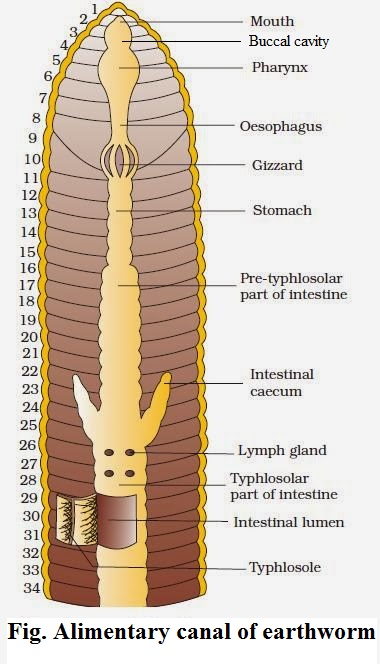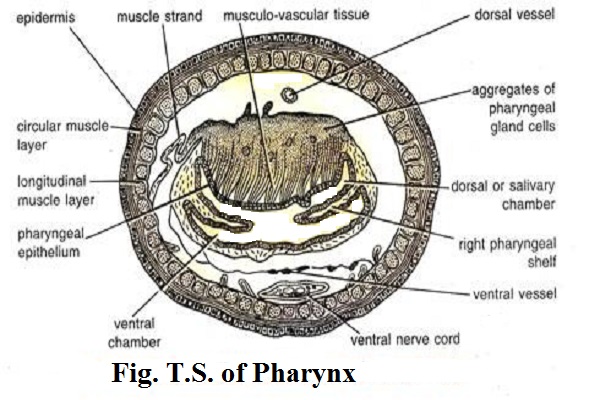Digestive System of Earthworm
Digestive System of Earthworm
Digestive system of earthworm consists of alimentary canal and glands along with physiology of digestion.
Alimentary Canal
Alimentary canal is long and straight,extending from mouth to anus. It consists of following parts:
- Mouth : 1st segment
- Buccal Cavity : 2nd-3rd segment or middle of 3rd segment
- Pharynx : 3rd-4th segment
- Oesophagus : 5th -7th segment
- Gizzard : 8th or 8th-9th segment
- Stomach : 9th or 10th-14th segment
- Intestine : 15th up to last segment except anus
- Anus : last segment

- Mouth
It is crescentic aperture situated in the 1st segment below the prostomium.
Mouth leads into a buccal cavity.
Ingestion of food takes place through it.
- Buccal Cavity
It is a short, wider, thin-walled tube extending from 2nd up to 3rd or middle of 3rd segment. It consists of two kinds of muscle. They are: protractile muscle and retractile muscle.
Buccal cavity protrude out through mouth with the help of special muscle for holding the food particles during feeding.
Buccal cavity leads into spacious organ called pharynx.
- Pharynx
It is small, swollen, wider, thick-walled pear-shaped chamber, which extends up to 4th segment.
It is wider than buccal cavity.
It is distinguished from buccal cavity by means of constriction.
It has pharyngeal gland, located in the dorsal salivary chamber. Pharyngeal gland is composed of many chromaphil cells, which produce saliva containing proteolytic enzyme; protease and mucin. Mucin makes the food soft and protease converts protein into amino acid.
- Oesophagus
It is narrow thin-walled tubular structure extending from 5th to 7th segment.
It has no gland.
It passes the food particles from pharynx to gizzard.
It leads into gizzard.
- Gizzard
It is oval, thick-walled and highly muscular organ lying in the 8th or 8th-9th segment.
It is the hardest part of alimentary canal due to the presence of inner lining of cuticle. It also possess chitinuous teeth like projection. It helps in grinding or crushing food so act as grinder during feeding.
- Stomach
Gizzard leads to short, narrow, thin-walled, highly vascular tubular structure called stomach, which extends from 9th or 10th to 14th segment. It is wider than oesophagus.
It has calciferous gland which helps in neutralization of food by calcification process.
Stomach leads to intestine.
The glandular cell of stomach produce proteolytic enzymes for the digestion of protein.
- Intestine
It is long, wide and thin-walled tube which extends from 15th to last segment except anus. Its inner lining is ciliated, vascular, folded and glandular. Its intestinal lining is folded to form villi. One of the villi becomes larger and well developed than other called typhlosole which runs mid-dorsally from 27th to last 25th segment.
Typhlosole divides the intestine into 3 regions. They are:
i. Pre-typhlosolar region
It extends from 15th segment to 26th segment so it is the first part of the intestine.
It consists of villi but no typhlosole.
In 26th segment, there is a pair of short and conical lateral outgrowth called intestinal caeca which extends upward up to 23rd segment. Intestinal caeca produce amylase which helps in starch(carbohydrate) digestion.
ii. Typhlosolar region
It is the 2nd or middle part of the intestine which extends from 27th segment to last from 25th segment. It has both villi and typhlosole.
The typhlosole is highly vascular and glandular fold that increases the absorptive surface area of the intestine.
iii. Post-typhlosolar region
It is the last part of the intestine lying in the last 23rd-25th segment in front of anus. It is also called rectum.
It lacks villi and typhlosole.
It contains small pellets of mud which are thrown out through the anus to form casting.
- Anus
It is a circular opening in the last segment called anal segment.
Undigested food materials release out through anus in the form of worm casting.
Digestive glands
There are different types of digestive glands associated with alimentary canal of earthworm.
- Pharyngeal gland
- Gastric gland
- Intestinal glands
- Intestinal caeca
Physiology of digestion
Digestion is the bio-chemical process in which complex organic food is broken down into simple, soluble and diffusible form in the presence of respective enzymes.
Earthworms feed upon all kinds of organic humus and debris such as decaying leaves and seeds, protozoan, etc. present in soil. They also feed directly on leaves, grasses and other vegetation.
During feeding the buccal cavity is protrude out with the help of protractile and retractile muscle. Then the food is drawn into the mouth. The ingested food enters into pharynx through buccal cavity. The dorsal chamber of pharynx consists of pharyngeal gland which is composed of chromaphil cell which produce saliva containing mucin and protease. Mucin lubricates the food and protease converts protein into amino acids. The foods then pass through oesophagus into gizzard, where grinding or crushing of food material takes place into fine state due to the contraction of circular muscles of gizzard. The grinded food material enters into the stomach where the neutralization of food takes place by calcification process. Also there occurs the complete digestion of protein by proteolytic enzymes. Now the food material enters into intestine. In intestine, intestinal caeca produce amylase which converts starch into glucose.
In intestine several enzymes are secreted and acts on the substrate as follows:
- Protease: converts protein into amino acid.
- Amylase: converts starch into two molecules of glucose i.e. maltose.
- Cellulase: converts cellulose into glucose
- Chitinase: digest chitin of exoskeleton of insects.
- Lipase: converts fats into fatty acids and glycerol.
Digestion occurs mostly in the intestine and the digested food is absorbed by villi. Then pass into blood stream through capillaries. Undigested food and the soil are released out in the form of casting through anus.
T.S. of Pharynx

Pharynx is small, wide, thick-walled, pear-shaped chamber. Two chambers are found in pharynx. They are: dorsal chamber and ventral chamber.
The dorsal chamber is also called salivary chamber which contains pharyngeal gland that is composed of many chromaphil cells. Dorsally pharyngeal gland is lined by villi. The chromaphil cells produce saliva containing proteolytic enzymes and mucin. Mucin makes the food soft and protease converts protein into amino acid. The ventral chamber is a conducting chamber which conducts digested or undigested food material from pharynx to oesophagus. Pharynx acts as sucking and pumping organ during feeding.

Thankyou very much mam
Thankyou mam
Thank you mam
Thanks it is desirable understand well
Thank you mam it is desirable understand well
Very useful
thank u mam
Thankss…..
Really useful .. language used is easy to understand
Well understable. 👍
Thank you mam
Thanks to you